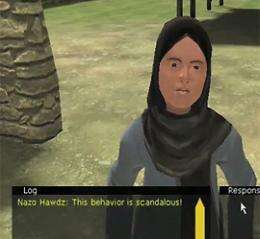Game Lets Soldiers Train in a Virtual Iraq or Afghanistan

(PhysOrg.com) -- A training tool being developed by a research team from the Arts and Technology program may soon make it easier for military service men and women to perform their missions in Iraq and Afghanistan. The First Person Cultural Trainer is a 3D interactive training game teaches soldiers the values and norms of Iraqi and Afghan cultures.
A training tool being developed by a research team from the Arts and Technology (ATEC) program may soon make it easier for military service men and women to perform their missions in Iraq and Afghanistan.
“The work we’re doing has to do with the facilitation of cultural training,” said Dr. Marjorie Zielke, an assistant professor in the ATEC program and the principal investigator on the project. “The way some of that training has been done in the past and may still be done in certain areas is to build actual villages and hire actors to replicate a particular culture,” Zielke said. “That kind of approach has some limitations in the sense that it’s expensive, not everyone can attend, it’s not easily changed because it’s a physical structure, you have to work with actual actors, and so forth.”
The ATEC team set out to re-create a realistic virtual environment instead. The result is First Person Cultural Trainer (FPCT), a 3D interactive game that teaches soldiers the values and norms of Iraqi and Afghan cultures. FPCT is a serious game, which means that it is designed for purposes other than pure entertainment, in this case, cultural training.
FPCT recently won the Cross-Function Team Award at the 2010 Modeling & Simulation Leadership Summit, held in Virginia Beach. Presented annually by the National Training & Simulation Association (NTSA), the Modeling & Simulation (M&S) Awards recognize achievement in the M&S functional areas of training, analysis and acquisition, and in support of the overall M&S effort.
First Person Cultural Trainer was also a finalist at the Interservice/Industry Training, Simulation and Education Conference (I/ITSEC) in Florida in early December. I/ITSEC promotes cooperation among the armed services, industry, academia and various government agencies in pursuit of improved training and education programs.
Zielke says ATEC has been working in the cultural training and simulation area for about three years, with about 15 students - at the undergraduate, graduate and doctoral levels - working on this project. Her co-investigators are Dr. Thomas Linehan, Endowed Chair and director of Arts and Technology at UT Dallas; and Dr. Frank DuFour, assistant professor of sound design.
“Much of the cultural data is being developed in real time by the military,” Zielke said. “By having it in a systems-based approach that is composable — in other words, we can generate culture in certain aspects of the game on the fly — we can respond to the data as soon as it becomes available. We could change it overnight if we needed to.”
“This prototype, now on its way to a full-fledged model, is a highly flexible tool for training battle staffs and individual soldiers at the tactical level,” said Mel Cape, senior knowledge engineer for TRADOC G2. “The recognition [the UT Dallas team] has received within the modeling and simulation community is well deserved, and we at TRISA are proud of their superlative efforts in the development of a culturally-based training device.”
Part of this cultural training is to familiarize soldiers with what they will face when arriving in their theaters of operation. Researchers worked to make the game’s characters look, sound and act as much as possible like people from the culture they represent.
In the game, the player enters a community from the first-person point of view. He doesn’t know much about the community, how the people feel about him, or who the key figures are in the village. The goal is to move through the community and try to understand the social structures and issues, then address those issues and work with the community to affect missions.
The people in the community form opinions about the player based on how the player treats them. If the player doesn’t interact properly with them, the villagers discuss his behavior among themselves. Some individuals in the village have more clout than others.
The player collects information based on verbal and non-verbal cues he observes in the characters he encounters and then rates those characters based on a scale of four emotions: anger, fear, gladness and neutrality.
One of the most rewarding aspects of this program for Zielke is the opportunity to help her students make connections within the industry. “Between this project and other similar projects in the ATEC program, we have at least 30 students employed at any given time,” she said. “The students develop great portfolios, gain work experience, go to conferences, write research papers based on an incredibly rich data set and then hopefully leverage all of those things to get industry jobs.”
The project is supported and sponsored by the U.S. Army Training and Doctrine Command (TRADOC) G-2 Intelligence Support Activity (TRISA).
Provided by University of Texas at Dallas

















